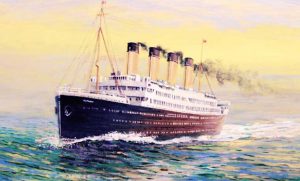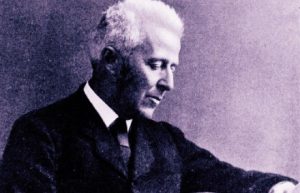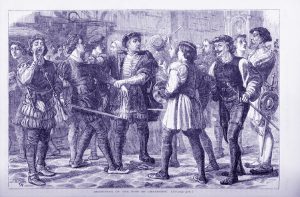
It’s been a while since a miniseries this good crossed the Atlantic. Titanic: Blood & Steel proves there are still ways to approach old material in new ways. From the laying of the hull to her departure from Belfast, this is the story of the workers, businessmen, and common Irishmen affected through the construction process of the most famous ship in history.
The year is 1909. American businessman J.P. Morgan (Chris Noth) has provided the financial banking for three magnificent ships, his favorite among them the RMS Titanic. Ambitious Marc Meur (Kevin Zegers) is eager to be in at the ground floor. Fresh off steel-testing for an American warship, he offers his services to Morgan’s business partner Lord Pirrie (Derek Jacobi) to ensure their ship is the safest, most reliable vessel at sea. Taken under the wing of the ship’s designer, Thomas Andrews (Billy Carter), it doesn’t take Marc long to settle in… and start having doubts about the way Titanic is being constructed.
But that is the least of Belfast’s problems. Strife erupts in the shipyard when popular liberal unionist Jim Larkin (Liam Cunningham) tries to rally the Irish workers. Lovely young copier Sofia (Alessandra Mastronardi) gets caught up in the movement, to the distress of her traditional Italian father. The aristocratic Kitty (Ophelia Lovibond) vies for the attention of Marc. The miniseries plays out against a backdrop of political upheaval and unrest, board inquiries whether the White Star ships are “too big,” and the collision of the Olympic’s impact on the construction of Titanic’s hull.
The series’ strengths are its historical figures, such as the open-minded Pirrie (Jacobi at his finest) and the perfectionist, driven Andrews, who is depicted as I always imagined him to be, soft-spoken and heroic. These two figures are fantastic, and I wish they had been the main characters, because I don’t like anyone else! Whenever they are around, I adore what the script shows me, how it emphases the politics and passions of the period, and shows me aspects of shipbuilding. Unfortunately, the story is about Marc, and I hate him. He is a hypocritical, self-righteous jerk who learns nothing from his mistakes and is amoral, yet walks around in judgment of everyone else.
The scripts cannot understand the social and sexual mores of the time, thus encouraging promiscuity to a level that would have been frowned on. It relies more on fiction than fact to tell its story, but explores the politics of the era: the struggle to unionize Ireland, the rivalries between Catholic and Protestant fractions, even a foray into the beginnings of the Irish Republican Army.
It’s an expensive miniseries, and it shows not only in the terrific cast but the incredible detail on the ships, their construction, the shipyards, and the lavish interiors. Despite my hatred for many of its characters, I keep it on my shelf mainly for the glorious moment when they launch Titanic. It is also proof that no topic is so overdone, a clever writer can’t approach it with a new perspective. The conclusion is ominous and the futures of everyone (save poor Andrews) are unclear, for the series ends as Titanic embarks on her icy maiden voyage with most of the main cast aboard. Those hopeful for a resolution will feel disappointed, but it gave me twelve hours in the companionship of Lord Pirrie and Thomas Andrews… and as an amateur RMS Titanic historian, for that, I’m grateful.
SEXUAL CONTENT: Implications of premarital sex (unmarried couples snuggling in bed together several times; a man and woman undress and kiss one another; pregnancy out of wedlock); groping, partial undressing, and kissing happen before an interruption; references to affairs; two characters have children out of wedlock.
LANGUAGE: A half dozen exclamations of Jesus/Christ’s name.
VIOLENCE: A man’s leg is sliced open by falling steel; we see the gory, gaping wound; men are shot and beat up in riots.
OTHER: Characters profess to be Catholic or Protestant, but their behavior reveals it is only political and not any religious conviction on their part. (One even abuses Jesus’ name in church.) Drinking/smoking.
Want more stories set aboard the doomed Titanic and in the heart of Edwardian Belfast? Discover The Secret in Belfast, where faith, fate, and a siren’s song intertwine with the lives of real historical figures.
TITANIC BLOOD AND STEEL HISTORICAL ERRORS
While entertaining, the series is abundant with historical inaccuracies. Let’s fact-check!
- The premise of this series operates off the assumption the plate-making process the White Star Line used weakened the steel used to form Titanic’s hull. However, they used identical steel in her sister ship, Olympic, which collided with two separate vessels and survived; Titanic’s hull is intact on the ocean floor.
- They say Titanic is larger than Olympic, where they were the same length, width, and tonnage.
- Thomas Andrews is shown as being indifferent about fixing the “steel problems”; he was a perfectionist and at the forefront of supporting improvements for Titanic’s safety (such as additional lifeboats). He was also a burly, good-natured man, and adored by everyone who worked at Harland & Wolff, not the stern, disapproving man we see on screen.
- Captain Smith speaks of a storm that worried him about Olympic’s capabilities as a safe vessel; actually, it proved her superior design and was undamaged afterward (she did not have to “limp into New York harbor”). Any concern about the enormous size of the ships is over-exaggerated.
- The timeline of this miniseries is incorrect pertaining to the building of Titanic and Olympic; the latter is in usage as the former is beginning construction (the ships were built side by side, and Olympic launched a year ahead of her sister ship). Though Olympic’s collision with the Hawke forced Titanic out of her dry dock for repairs, unlike as depicted, Titanic was already much further along in the fitting-out process.
- When Thomas Andrews assesses the damage to Olympic, the damage is shown on her forward-port quarter, instead of her aft-starboard quarter.
- The blueprints seen for Titanic are of the Cunard liner Lusitania (1907).
- Several main characters start their journey in Belfast. Only crew members, Thomas Andrews, his “guarantee group,” and a Board of Trade official boarded the ship in Belfast; all other passengers had to board in Southampton.







